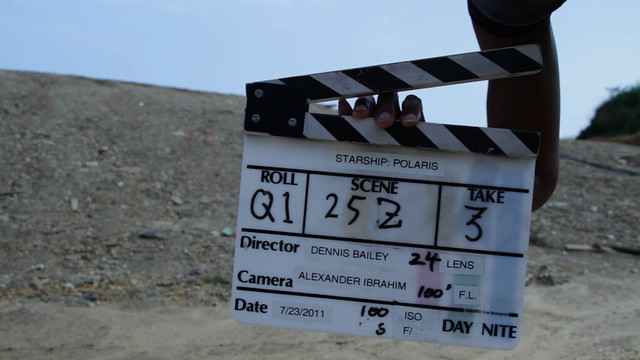Overdue for a new topic. Let's talk about something pretty elementary but I rarely see discussed...
THE SLATE (CLAPPERBOARD)
The guy or gal snapping the "clapper" shut at the start of a take is so commonplace that it's cliché. But even some beginning filmmakers don't quite understand its full purpose.
Let's talk about the Clapper first. The two bars at the top are called the "sticks" or "clapper sticks" and the reason they're snapped together on-camera is to give the editor an audible
and visible cue for synchronizing sound and picture (especially important if you're recording sound to a different device than the camera).
The Slate (so-called because in the past it was a slate surface on which you wrote in chalk) is used to visually include the information related to a given take within the take itself. This allows footage to be easily identified when reviewing or editing. It's actually fairly important for this reason. If camera logs or other records get lost, the critical information is built into the take.
Typically, a slate contains the following info:
- PRODUCTION NAME/#: What movie or episode this is
- ROLL: The number of the film roll/tape/ or memory card being recorded to
- SCENE: The scene # being shot, as identified in the shooting script, often appended with a letter to indicate different camera setups
- TAKE: Which take # of the indicated scene is being shot
- DATE: The date of the shoot
- DAY/NITE: This is used to indicate if the scene is supposed to take place in daytime or nighttime, not when it was actually shot. Sometimes you shoot "day for night" (footage shot in daylight and processed to simulate night), etc.
Traditionally, slates also contain the name of the Director and the Cinematographer.
Below is a typical slate.
Slate for a synced sound take with camera info
Slates may also contain additional information, such as:
- MOS: Some Slates feature the text MOS, which is circled if the shot is NOT being recorded with sync sound or if the shot contains no sound that matters. However, it's easier to indicate MOS just by having the person slating place their fingers between the clapper bars, which shows that there will be no clap, ergo MOS.
- CAMERA TYPE: If different cameras are being used, the camera name is often written on the slate. This is useful when identifying what needs to be done with footage when you're mixing camera types or need to match the camera in later shots.
In these POLARIS slates you'll also see the following:
- LENS: The lens size size being used
- F.L.: The Focal Length of the take
- ISO: The "film speed", or the digital equivalent setting on the camera
- F/: The F-stop (such as F/5.6)
This information is typically recorded in the Camera Log made by the camera crew (allowing you to match the look of other shots made for the scene days or weeks later) but in some cases you put it on the slate. Why? In these cases, it's because there will be visual effects added to the shots, and this information is recorded on the slate so that the visual effects people can see it on the shots they're working on.
MOS (no sound) slate. MOS is indicated by the 2nd Assistant Camera's fingers holding the clapper open.
SLATE PROTOCOL
Typically, the Slate is handled by the
Second Assistant Camera (2nd AC) or "clapper loader" (more common in Europe) who fills in the Slate and hold it in front of the camera and claps the clapper.
Here's the way it's called on many shoots:
A.D. (Assistant Director): Roll Camera.
CAMERA OPERATOR: Speed.*
A.D. Roll Sound.
SOUND RECORDIST: Speed.*
A.D. Mark it.**
2nd ASST. CAMERA: Scene 25 Foxtrot, Take 2. (CLAP)
*Means the device is recording at speed.
**Means "Do the slate thing."
Once the the Slate is cleared of the scene, the Director can call Action at her discretion.
NOTES:
When slating
any shot where sound is being recorded, the person handling the Slate reads off the scene and take number before clapping. This ensures that the scene and take information is recorded on the soundtrack in addition to the clap for synchronization.
It's REALLY IMPORTANT to make sure the Camera and Sound are rolling for a few seconds before you "mark it" with the slate, otherwise you risk the slate not being on camera or the clap sound not being recorded.
Because the slate is designed to be easy to erase, it's also easy to erase things that don't change. As such, it's pretty common to stick tape to the slate with information that doesn't change much or at all.
THE TAIL SLATE
Finally there's one additional slating convention. The TAIL SLATE is done when, for whatever reason, it's not possible or convenient to film the Slate at the head of the take. In such a case the shot is done without a slate at the start but, before the Director yells "Cut", a "Tail Slate" is called for. The 2nd Camera Assistant does the Slate thing BUT to indicate it's a Tail Slate, the Slate is brought in normally, then flipped UPSIDE-DOWN at the end to show it's the end of the shot.
(CLICK HERE to see an example of a Tail Slate from "Spock's Brain".)
Oh, and the thing used to wipe the Slate is called the MOUSE.







